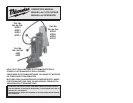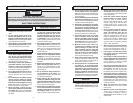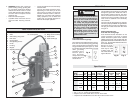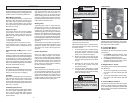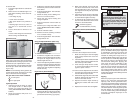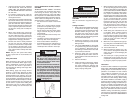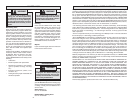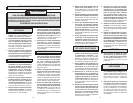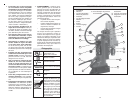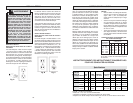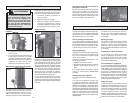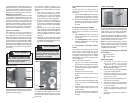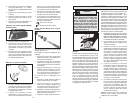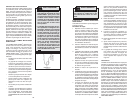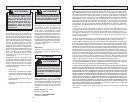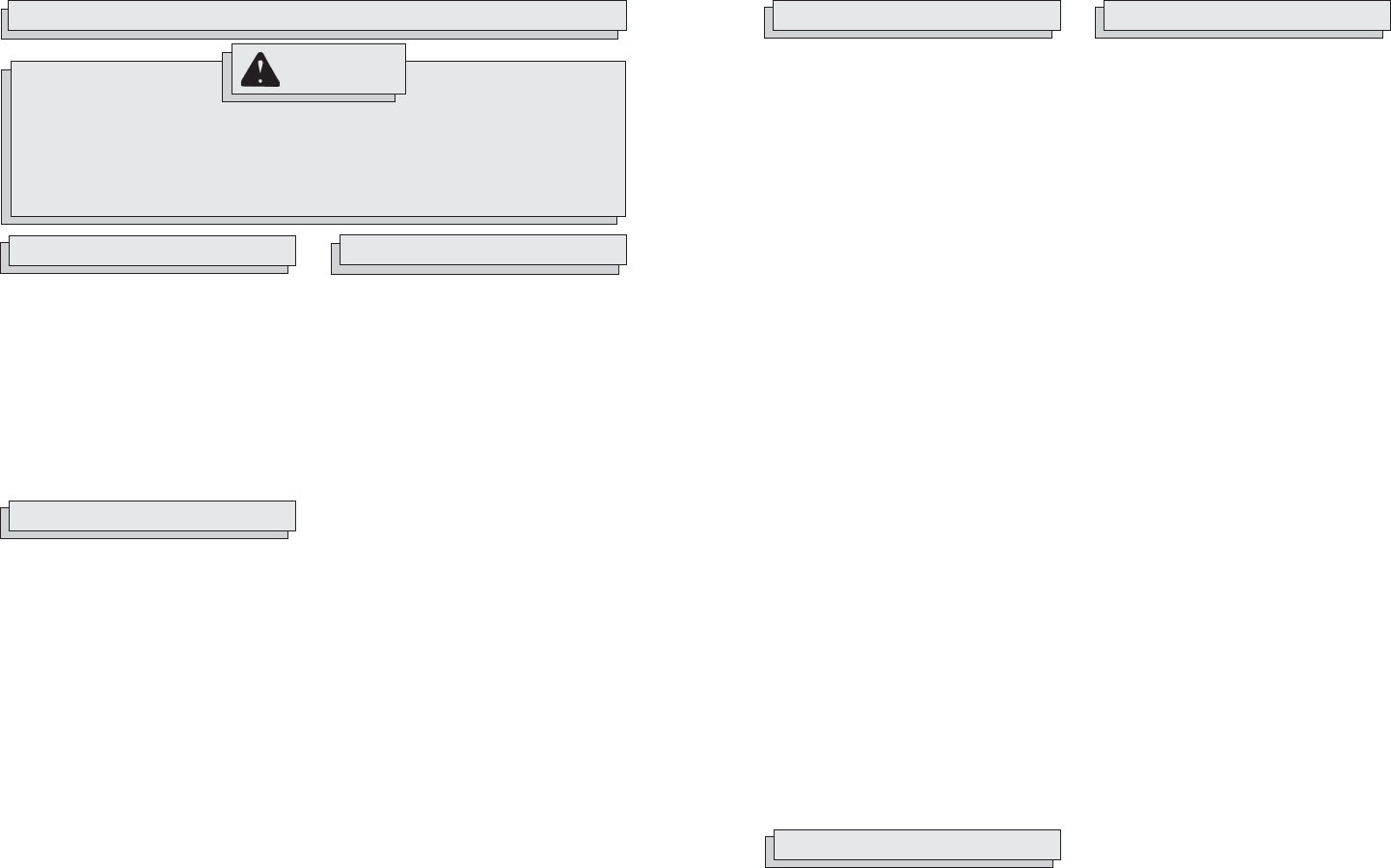
2 3
GENERAL SAFETY RULES — FOR ALL POWER TOOLS
WORK AREA SAFETY
ELECTRICAL SAFETY
PERSONAL SAFETY
WARNING
READ ALL INSTRUCTIONS
Failure to follow all instructions listed below may result in electric shock, fi re and/or
serious injury. The term "power tool" in all of the warnings listed below refers to your
mains-operated (corded) power tool or battery-operated (cordless) power tool.
SAVE THESE INSTRUCTIONS
1. Keep work area clean and well lit.
Cluttered or dark areas invite acci-
dents.
2. Do not operate power tools in ex-
plosive atmospheres, such as in the
presence of fl ammable liquids, gases
or dust. Power tools create sparks which
may ignite the dust or fumes.
3. Keep children and bystanders away
while operating a power tool. Distrac-
tions can cause you to lose control.
4. Power tool plugs must match the
outlet. Never modify the plug in any
way. Do not use any adapter plugs
with earthed (grounded) power tools.
Unmodifi ed plugs and matching outlets
will reduce risk of electric shock.
5. Avoid body contact with earthed or
grounded surfaces such as pipes,
radiators, ranges and refrigerators.
There is an increased risk of electric shock
if your body is earthed or grounded.
6. Do not expose power tools to rain or
wet conditions. Water entering a power
tool will increase the risk of electric
shock.
7. Do not abuse the cord. Never use the
cord for carrying, pulling or unplug-
ging the power tool. Keep cord away
from heat, oil, sharp edges or moving
parts. Damaged or entangled cords
increase the risk of electric shock.
8. When operating a power tool out-
doors, use an extension cord suitable
for outdoor use. Use of a cord suitable
for outdoor use reduces the risk of elec-
tric shock.
9. Stay alert, watch what you are do-
ing and use common sense when
operating a power tool. Do not use
a power tool while you are tired or
under the infl uence of drugs, alcohol
or medication. A moment of inattention
while operating power tools may result
in serious personal injury.
10. Use safety equipment. Always wear
eye protection. Safety equipment such
as dust mask, non-skid safety shoes,
hard hat, or hearing protection used
for appropriate conditions will reduce
personal injuries.
11. Avoid accidental starting. Ensure the
switch is in the off-position before
plugging in. Carrying power tools with
your fi nger on the switch or plugging in
power tools that have the switch on invites
accidents.
12. Remove any adjusting key or wrench
before turning the power tool on. A
wrench or a key left attached to a rotat-
ing part of the power tool may result in
personal injury.
13. Do not overreach. Keep proper foot-
ing and balance at all times. This
enables better control of the power tool
in unexpected situations.
14. Dress properly. Do not wear loose
clothing or jewellery. Keep your hair,
clothing and gloves away from moving
parts. Loose clothes, jewellery or long hair
can be caught in moving parts.
15. If devices are provided for the connec-
tion of dust extraction and collection
facilities, ensure these are connected
and properly used. Use of these de-
vices can reduce dust-related hazards.
POWER TOOL USE AND CARE
16. Do not force the power tool. Use the
correct power tool for your applica-
tion. The correct power tool will do the
job better and safer at the rate for which
it was designed.
17. Do not use the power tool if the switch
does not turn it on and off. Any power tool
that cannot be controlled with the switch is
dangerous and must be repaired.
18. Disconnect the plug from the power
source and/or the battery pack from
the power tool before making any
adjustments, changing accessories,
or storing power tools. Such preven-
tive safety measures reduce the risk of
starting the power tool accidentally.
19. Store idle power tools out of the
reach of children and do not allow
persons unfamiliar with the power
tool or these instructions to operate
the power tool. Power tools are danger-
ous in the hands of untrained users.
20. Maintain power tools. Check for
misalignment or binding of moving
parts, breakage of parts and any
other condition that may affect the
power tool's operation. If damaged,
have the power tool repaired before
use. Many accidents are caused by
poorly maintained power tools.
21. Keep cutting tools sharp and clean.
Properly maintained cutting tools with
sharp cutting edges are less likely to
bind and are easier to control.
22. Use the power tool, accessories and
tool bits etc., in accordance with
these instructions and in the manner
intended for the particular type of
power tool, taking into account the
working conditions and the work to
be performed. Use of the power tool for
operations different from those intended
could result in a hazardous situation.
SERVICE
23. Have your power tool serviced by a
qualifi ed repair person using only
identical replacement parts. This will
ensure that the safety of the power tool
is maintained.
SPECIFIC SAFETY RULES
1. Always use safety chain. Mounting
can release when drilling overhead or
on a vertical surface (See “Safety Chain”
under “Operation”).
2. Clean the surface before attaching
the drill stand to the work surface.
Paint, rust, scale, or uneven surfaces
decrease the holding strength or the
magnet. Chips, burrs, dirt and other
foreign matter on the surface of the
magnetic base will also decrease hold-
ing power.
3. Do not attach magnetic base to
nonmagnetic grades of stainless
steel. The magnetic base will not
hold. The electro magnetic drill press
attaches magnetically to any ferrous
metal. It is designed for use on 1/2 inch
or thicker ferrous stock. Holding power
will decrease on thinner stock. A back
up plate must be used (See “Backing
Plate" under “Operation”).
4. Wet connections are shock hazards.
Prevent cutting fl uid from traveling along
the cord and contacting the outlet, ex-
tension cord connections or tool plug.
5. If the plug or connections get wet,
turn power off to the outlet before
unplugging the tool.
6. Use clamps or other practical way to
secure and support the workpiece to
a stable platform. Holding the work by
hand or against your body is unstable
and may lead to loss of control.
7. Use only accessories that are rec-
ommended by the manufacturer for
your model. Accessories that may
be suitable for one tool, may become
hazardous when used on another tool.
8. Hold power tools by insulated grip-
ping surfaces when performing an
operation where the cutting tool may
contact hidden wiring or its own cord.
Contact with a “live” wire will make ex-
posed metal parts of the tool “live” and
shock the operator.
9. Wear ear protectors with impact
drills. Exposure to noise can cause
hearing loss.
10. Maintain labels and nameplates.
These carry important information.
If unreadable or missing, contact a
MILWAUKEE service facility for a free
replacement.



